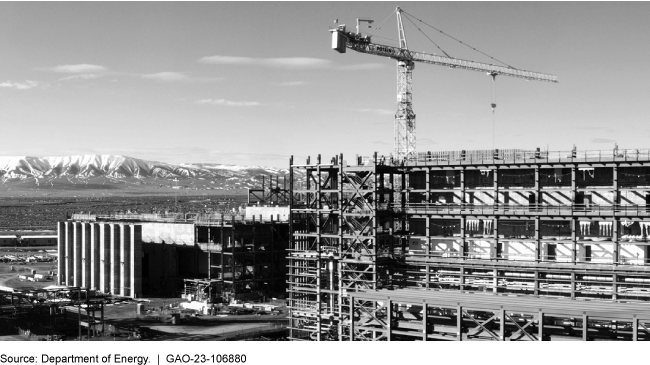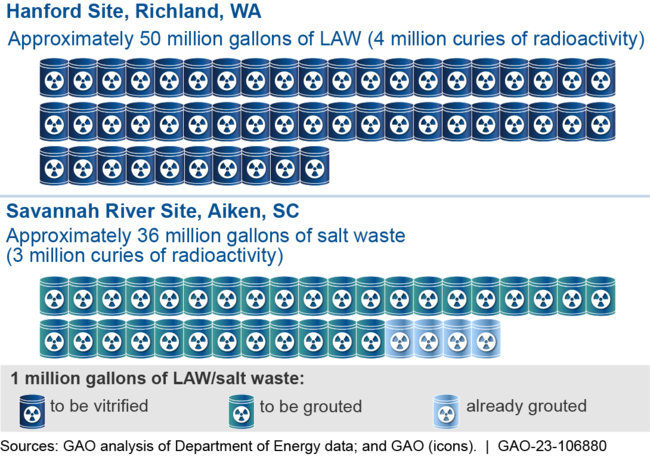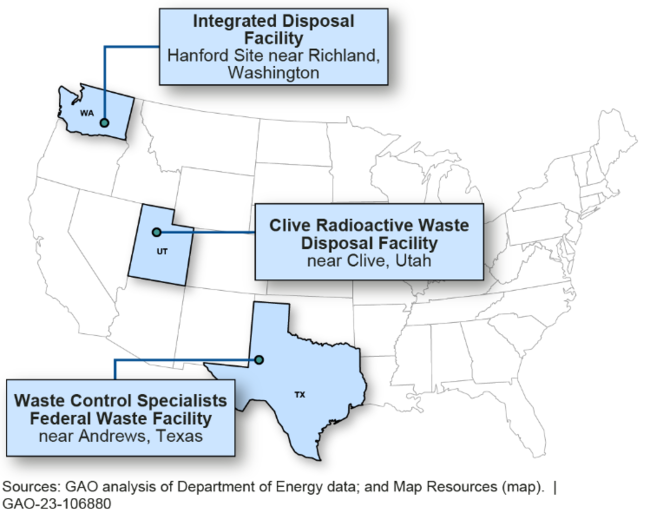Hanford Cleanup: Alternative Approaches Could Save Tens of Billions of Dollars
Fast Facts
The Hanford Site in Washington State is one of the largest and most expensive environmental cleanup projects worldwide. We estimated in 2022 that the cleanup will cost between $300 billion and $640 billion and take decades.
In this Snapshot report we cover steps the Department of Energy and Congress could take to save money and reduce risks posed by the site's 54 million gallons of radioactive tank waste.
For example, DOE could save tens of billions of dollars by mixing the waste with a concrete-like mixture instead of molten glass. We've recommended Congress clarify DOE's authority to manage and dispose of waste to reduce risks and save money.
High-level Waste Facility Construction at the Hanford Site in Washington State

Highlights
The Big Picture
The Department of Energy (DOE) is responsible for the treatment and disposal of about 54 million gallons of radioactive and hazardous waste stored in tanks at the Hanford Site in Washington State. Before treating this waste, DOE plans to separate it into two streams. The first will be a less radioactive portion, which DOE calls “low-activity waste,” or LAW, and estimates will comprise about 95 percent of the tank waste volume and 3 percent of the radioactivity. The second will be a more radioactive portion, which DOE calls “high-level waste” and estimates it will compromise about 5 percent of the tank waste volume and the majority of the radioactivity. As we reported in 2022, DOE estimates that cleaning up the entire Hanford Site will cost between $300 billion and $640 billion and take decades.
DOE currently plans to use the Waste Treatment and Immobilization Plant (WTP) at Hanford to vitrify all of the site's tank waste. Vitrification is a treatment process that will immobilize the waste in glass. The WTP, which has been under construction since 2000, is currently designed to vitrify only about 60 percent of Hanford's LAW once the facility is completed. DOE's cost estimate for completing cleanup of the entire site assumes that the remaining 40 percent of the LAW—known as “supplemental LAW”—will also be vitrified. However, DOE has not yet determined how it will treat the supplemental LAW.
In contrast, at the Savannah River Site in South Carolina, DOE is planning to treat salt waste—which is similar to Hanford's LAW—by immobilizing it in a concrete-like mixture called grout. This approach is significantly cheaper than what is proposed at Hanford.
What GAO’s Work Shows
Since 2017, we have found that opportunities exist for Congress and DOE to take steps now that could save money and reduce certain risks posed by Hanford's tank waste.
DOE has taken some actions following our recommendations. For example, DOE is testing alternative treatment and disposal options for supplemental LAW. We have identified additional opportunities for DOE to explore cost savings:
- Alternatives to Glass. We found in May 2017 that using alternative treatments to vitrification, such as immobilizing the waste in grout, could reduce certain risks by treating the waste faster and could save tens of billions of dollars. The best available information indicates that DOE's estimated costs to grout the salt waste at the Savannah River Site are substantially lower than its estimated costs to vitrify all of the LAW at Hanford (see table).
Estimated Cost to Build Facilities and Treat Low-Activity Waste (LAW) and Salt Waste
|
Site |
Cost ($ million) |
Cost per gallon ($) |
Cost per Curie($) |
|---|---|---|---|
|
Hanford |
70,000 |
1,400 |
17,500 |
|
Savannah River |
7,000 |
200 |
2,300 |
Source: GAO analysis of Department of Energy (DOE) data. | GAO-23-106880
Notes: Estimated costs are rounded and are in fiscal year 2023 dollars based on escalated dollar estimates provided by DOE. Curies are estimates as of 2022. Curies are a measure of the intensity of the amount of radiation released when an element emits energy as a result of radioactive decay. For additional information, see GAO-17-306.
Notably, we reported in May 2023 that DOE had found that tank waste treatment alternatives relying on grout are cheaper than those relying on vitrification and that DOE could save approximately $95 billion (escalated) over the next 50-60 years by grouting a portion of the LAW rather than vitrifying it. At the Savannah River Site, DOE has treated about 4 million gallons of salt waste using grout.
Treatment Status of Low-Activity Waste (LAW) at Hanford Compared with Salt Waste at Savannah River

Note: For additional information, see GAO-22-104365.
- Off-Site Disposal. If DOE decides to grout the supplemental LAW at Hanford, several potential options exist for disposal, including off-site at two commercial facilities—Clive Radioactive Waste Disposal Facility in Utah and Waste Control Specialists in Texas—that are licensed to receive similar waste. In 2021, we estimated that grouting the supplemental LAW could cost less and be faster to complete, even accounting for the costs of off-site transportation. DOE has been testing the feasibility of grouting, transporting, and disposing of some of Hanford's LAW off-site. However, alternative treatment and disposal options face legal uncertainty, and DOE officials expect its efforts will be the subject of litigation due to disagreements with regulators and others regarding how DOE must manage its tank waste.
Potential Disposal Sites for Grouted Low-Activity Waste from Hanford

Note: For additional information, see GAO-22-104365.
Challenges and Opportunities
As a matter of policy, DOE currently manages all Hanford tank waste as if it is legally “high-level radioactive waste,” which is defined by federal law and subject to specific requirements. DOE's ability to implement alternative treatment and disposal options for LAW is contingent, in part, on its ability to manage LAW as something other than high-level radioactive waste. Legislation clarifying DOE's authority to do so could help DOE reduce risks posed by leaking tanks, expedite treatment, and save billions of dollars.
Thus, we have noted that Congress should consider
- clarifying DOE's authority to determine whether portions of Hanford's waste can be (1) managed as a waste type other than high-level radioactive waste ( GAO-17-306 ) and (2) disposed of outside the state of Washington ( GAO-22-104365 ); and
- authorizing DOE to classify the volumes of waste corresponding to an ongoing demonstration project at the Hanford Site ( GAO-22-104365 ) as something other than high-level radioactive waste and specifying that the vitrification treatment standard does not apply to this volume of waste.
For more information, contact Nathan Anderson at (202) 512-3841 or Andersonn@gao.gov.
